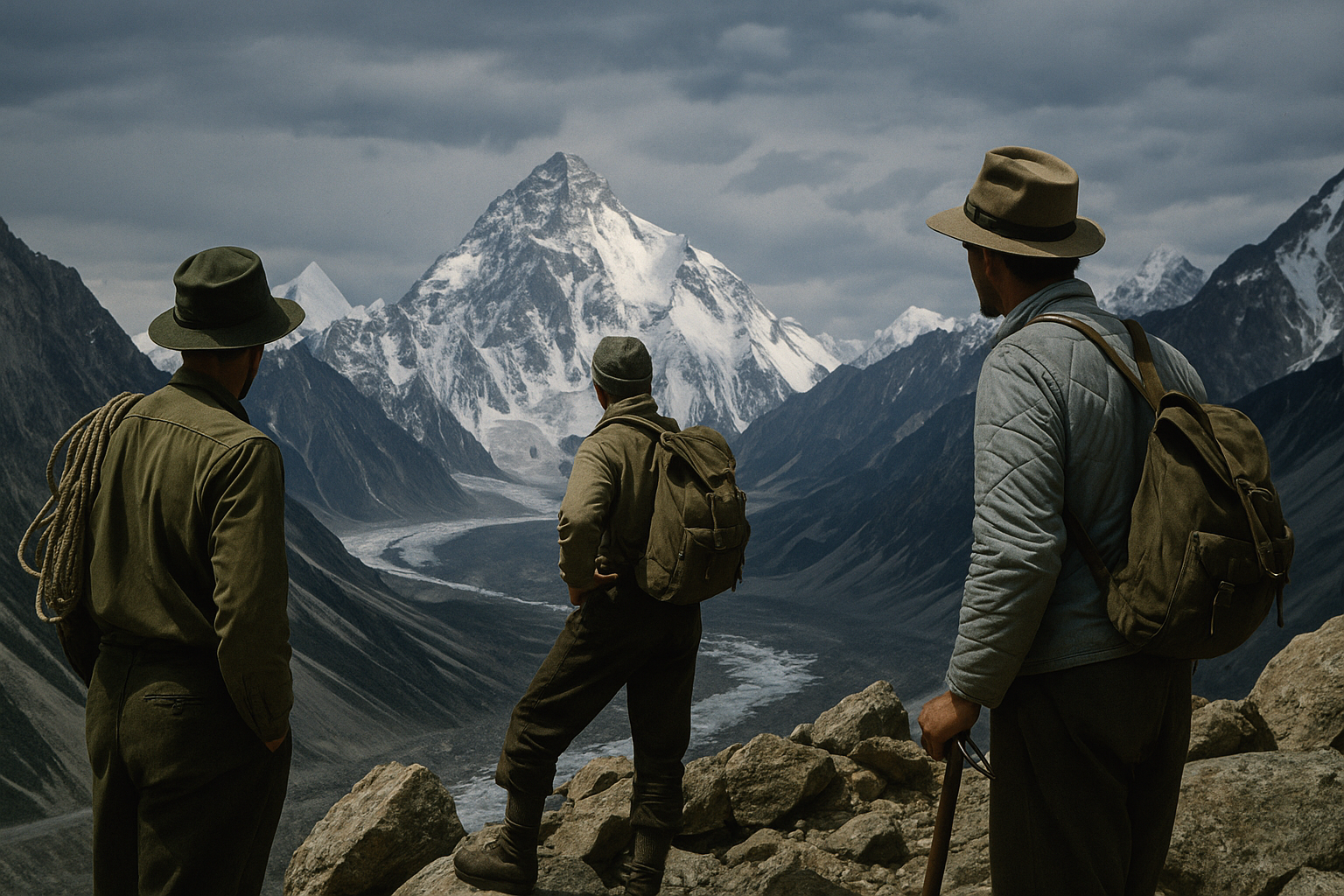Lost Behind the Ranges: American Mountaineers Confront the Savage Majesty of K2
When Americans picked up the March 16, 1940 issue of The Saturday Evening Post, they found within its pages more than just fiction, humor, and advertising. They discovered a sweeping adventure feature titled “Lost Behind the Ranges” by George C. Sheldon, a gripping account of an American expedition that attempted to scale K2—the 28,250-foot peak in the Karakoram, often described as the most dangerous mountain in the world.
For readers, this was far more than a climbing story. It was an encounter with the very limits of human courage and endurance. It was also a reflection of America itself on the eve of global conflict—an America defined by exploration, determination, and the belief that no frontier, however forbidding, was beyond reach.
The spring of 1940 was a turning point in global history. Europe was already at war, with Nazi Germany marching across the continent, while the United States remained officially neutral. At home, Americans were still recovering from the Great Depression, balancing hopes for prosperity with fears of another global crisis.
In this uncertain moment, The Saturday Evening Post offered both familiarity and escape. It carried fiction, humor, essays, advertisements, and richly reported features that transported readers far beyond their daily lives. The story of the American expedition to K2 did more than entertain—it symbolized American resilience and daring in a world that seemed increasingly unstable.
The expedition itself was extraordinary. Led by Fritz Wiessner, with climbers like Jack Durrance, Tony Cromwell, and Chappell Cranmer, the team set out across Kashmir and Little Tibet with Sherpa guides, supplies, and determination. They sought to conquer the “Savage Mountain,” a peak second only to Everest in height but far greater in difficulty.
For readers in 1940, this narrative was a reminder that even in an age of political anxiety, Americans were still reaching higher, testing themselves against nature’s greatest obstacles. It was a story of courage that mirrored the struggles the nation itself would soon face in war.
By 1940, The Saturday Evening Post was one of the most widely read magazines in the United States, reaching millions of households. Its mix of short stories, serialized novels, iconic cover art, advertisements, and long-form reporting made it both a cultural touchstone and a mirror of American life.
The March 16, 1940 cover reflected this spirit of adventure. It depicted American climbers gazing toward the vast Himalayan ranges, a visual promise of the story inside. Unlike the everyday Americana covers often illustrated by Norman Rockwell, this cover pointed outward—to the world’s highest peaks, symbolizing exploration, ambition, and discovery.
Inside, Sheldon’s article combined rich narrative, dramatic photography, and cultural context. Readers followed the expedition through the Vale of Kashmir, across glaciers, and up the dangerous slopes of K2. They learned of avalanches, frostbite, exhaustion, and the sheer peril of climbing at extreme altitude. Photographs of climbers, Sherpas, and the forbidding mountain landscapes brought the story vividly to life, bridging the gap between distant adventure and American living rooms.
-
The Savage Mountain – K2, standing at 28,250 feet, was described as even more perilous than Everest. Its unpredictable weather, remote location, and technical difficulty made it a near-impossible summit.
-
The American Team – Led by Fritz Wiessner, the expedition included Tony Cromwell, Jack Durrance, Chappell Cranmer, and others. Their backgrounds—ranging from Dartmouth students to seasoned climbers—reflected the diversity of American determination.
-
Sherpa Support – The Tibetan Sherpas, essential to every Himalayan expedition, carried loads, fixed ropes, and guided the team through treacherous terrain. Their presence highlighted the collaborative nature of high-altitude climbing.
-
Life and Death at Altitude – One of the climbers, Chappell Cranmer, fell gravely ill, demonstrating the razor-thin margin between survival and tragedy on such expeditions.
-
The Symbolism of Struggle – Though the summit was never reached, the story was not one of failure. Instead, it illustrated the American spirit of endurance, persistence, and courage in the face of overwhelming odds.
For readers, these moments were more than adventure—they were metaphors for the nation itself, preparing to confront challenges on a global scale.
For today’s collectors, the March 16, 1940 Saturday Evening Post holds significant value—not only as a piece of journalism, but as a cultural artifact.
-
Historical Timing – Published just months before America entered World War II, this issue captures a moment of tension and transition, where stories of courage abroad mirrored anxieties at home.
-
Adventure Reporting – Articles on mountaineering, particularly attempts on K2, are rare and highly collectible. They appeal to enthusiasts of exploration history and vintage adventure literature.
-
Iconic Covers – While Norman Rockwell covers command special attention, this issue’s striking Himalayan theme adds distinctive appeal for collectors.
-
Cultural Snapshot – Beyond the climbing feature, the issue includes period advertisements (Colgate, Stetson, Aunt Jemima), serialized fiction, and cartoons, making it a time capsule of American life in 1940.
Owning this issue is like holding a piece of American cultural history, complete with the hopes, humor, and anxieties of its era.
The endurance of The Saturday Evening Post lies in its ability to blend the ordinary and extraordinary. It was a magazine where a household could find short stories about American family life alongside reports from the world’s most remote frontiers. Its covers, often symbolic of national ideals, became iconic representations of the American spirit.
This duality—rooted in domestic life yet expansive in global outlook—is why the Post remains so culturally significant. For historians, collectors, and enthusiasts, each issue is a preserved piece of the American experience.
If you’re fascinated by this issue or others like it, you can explore our complete archive of original Saturday Evening Post magazines. From the Great Depression through World War II and into postwar America, these magazines document the evolution of culture, politics, and art in real time.
👉 Browse the full collection here:
Original Saturday Evening Post Collection
Whether you are a seasoned collector, a history buff, or someone honoring the memory of past generations, these magazines offer a direct and tangible connection to history.
The March 16, 1940 issue of The Saturday Evening Post, featuring George C. Sheldon’s “Lost Behind the Ranges”, remains a landmark publication. It brought the drama of the American K2 expedition into American homes, reminding readers of the courage, struggle, and determination that define exploration.
More than eighty years later, this issue still speaks to us—not just as a story of climbers in the Himalayas, but as a reflection of American ambition on the edge of history. It is both a thrilling narrative of survival and a collectible artifact of cultural heritage.
Holding this issue today means holding a piece of that moment in time, when the world stood at a crossroads, and Americans, whether on mountain slopes or in their own lives, pressed forward against impossible odds.

